A letterpress work in progress. We’re starting the corporate migration from Subversion to git and it seemed like a good opportunity to learn-by-printing. Still working on the press makeready; currently too much ink, which is filling in some of the letters. Watch the store.
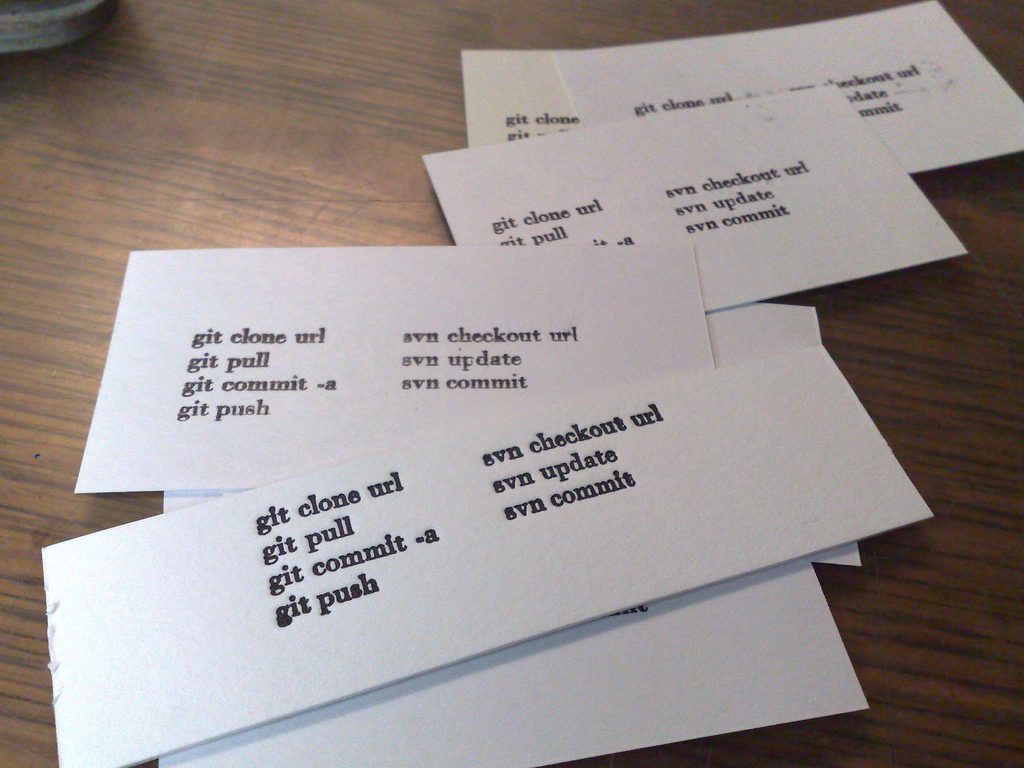
I imagine that, in an environment of tight budgets, limited staff and increasing demand, those involved in managing emergency rooms in today’s hospitals don’t have many spare cycles to consider the customer service aspect of what they do: if someone’s arm is falling off, or their heart has stopped, it’s probably a good idea that they’re focused on that, and not on the magazines in the waiting room.
And, if my eight hour experience in the Queen Elizabeth Hospital emergency room on Friday was any gauge, that’s exactly what they’re doing: focusing on the care, ignoring the service.
I was there because my family doctor sent me there: I’ve had a nagging cough for a month, and I was worried, waking up with a heavy chest, that it had migrated into pneumonia. It turns out that it hadn’t, something I learned after a 7 hour wait followed by a 3 minute consultation with a doctor and a quick chest x-ray. The wait itself didn’t bother me (okay, it did; but I understand the wait, and was happy to have babies with the croup triaged in ahead of me).
What was frustrating to see, as someone who cares about service design, is how small changes to the physical layout of the waiting room, the signage and the registration process could result in significant impacts on the “customer friendliness” of the process.
One example: on entering the emergency room I was faced with:
- a volunteer-less volunteer desk
- a large stand-up display marked “STOP” and instructions for what to do if I thought I had the flu
- a whiteboard with directions to walk-in medical clinics elsewhere in the city
There was, however, no suggestion, through signage or otherwise, as to what I should actually do on arrival. I wandered, at random, over to a window that said “Registration” and sat down, only to be told that I needed to go and “sit on the green couch and wait to be called.” Which I did. Ten minutes later I was waved over to the “Triage” window and given a number and told to go back to “Registration” and register. Which I did. I was then sent with a sheaf of paper back to “Triage” and told that I would be called. Thirty minutes later I was called in, had my vitals taken, and was sent back to the waiting room and told I’d be called back “when a spot opened up.” Seven hours later a spot opened up.
Again, I don’t dispute the seven hour wait, but as someone sick and exhausted and thinking he might have pneumonia, the first hour of the process, with its mysterious dance among windows seemed designed to confuse and perplex me. Even if the process itself cannot be re-engineered, simply informing me how it works immediate upon entry would go a long way to reducing stress.
Ironically, while I was waiting for my “spot to open up,” CBC’s Compass came on the television in the waiting room and aired a story about a plan to install “wait-time monitors” in the self-same waiting room. While this would certainly help, I’m not convinced that it really gets to the root of the issue, for I can’t imagine that the current process was designed by people with any notion of what it’s actually like to be an emergency room customer, and it’s only when that happens that the process and the approach to service can really be changed for the better.
This is hard to do: it’s almost impossible for people “on the inside” to see customer service from a customer’s point of view. Hospital administrators cannot arrive in the emergency room with fresh, naive eyes. And so what appears, to we customers, as a confusing maze of process likely appears well-laid-out and completely logical to them, especially if they’ve optimized the logistics for staff efficiency and not for customer service.
Certainly medical outcomes have to remain at the forefront, and I’m not suggesting that the doctor who treated me needed to be friendlier or should have spent more time with me. But I’m convinced, after having spent 7 hours watching people arrive in the emergency room and take on the same glazed look of confusion that I did, that by listening and watching customers, and by engaging someone with an eye to service design, medical outcomes could remain paramount but the front-end of the process could be redesigned with clear, up-front, customer-focused information and systems that would decrease confusion, reduce stress, and make putting up with the necessary wait times more bearable.
Last week in Berlin I overheard my friend Morgan recommend the book Managing Humans: Biting and Humorous Tales of a Software Engineering Manager to several people with enough enthusiasm that I figured I should look it up. So this afternoon I popped over to IslandLibraries.ca – the union catalogue of Holland College, the University of PEI and the Provincial Library system here in Prince Edward Island – and searched. And what should I find but:
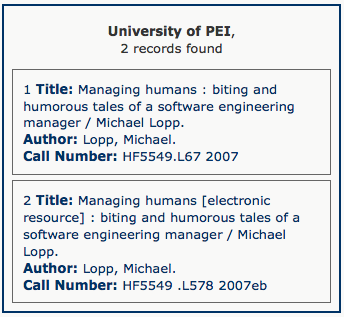
In other words, not only did the University of PEI library have Managing Humans in its collection, but it had it in both print and digital forms. A few minutes later, after logging in with my UPEI campus account, I was at MyiLibrary printing myself a PDF of the entire book.
Sometimes you just gotta remember to look.
Since Christmas this year I don’t think there’s been a single day when one member of our extended family here on the Island hasn’t had one illness or another: it’s not been a good winter for staying healthy.
Other than the annoying cough that has held me in its grip for a month and has Catherine in the thick of dread right now, the illness of the week at our house was a so-called “stomach flu” that, says the word on the street, is making its way through Prince Street School this month. It lasts about 48 hours and involves enough diarrhea to move our household to full “poovalanche” status.
Which got me thinking, again, about the area of health information that exists between the family doctor and “public health” and the kind of widespread mostly-not-too-serious illness that sweeps over a community that, because it’s not killing anyone, doesn’t cause the pandemic alarms to fire, but that is still life-affecting for a lot of families, and likely causes a lot of (perhaps unnecessary) doctor, walk-in clinic and emergency room visits.
What’s most distressing about this kind of illness is that, short of talking to teachers, friends and neighbours, it’s hard to get any information about what’s happening, what the best treatment is, and what practical steps should be taken (keep kids home from school? go to the doctor? wait it out?). For serious illnesses like the flu we’ve got information coming out of our ears, but for short term cold, cough and poovalanche episodes we’ve very little.
Oddly, the single most useful piece of information I received mid-poovalanche at our house came in this tweet from Stephen B. MacInnis: “the bug seems to last 48hr in acute phase. Then a week of Queasy. We are just getting over it.” he wrote, in reply to my original request for information on Twitter. In this case it was simply comforting to know that some other family was going through this too and that an end might be in sight: I wasn’t looking for treatment information or medical advice, just for moral support.
I’m the last person to suggest that “social media” should be applied as a technical solution to any societal problem, but this seems to be a situation where a “crowd-sourced” set of data supplemented by expert advice could be combined to provide a useful data set that would not only help individuals and families, but also assist schools, workplaces, walk-in clinics and others in capacity planning. And it may also allow some home-brew epidemiological work to take place that would help mitigate the impact of these “casual illnesses” in future.
What do you think?
Catherine will tell you many tales of our travels over the years that involved episodes – long, significant, “to the exclusion of all else” episodes – of driving about the countryside looking for open wireless access points so that I could slurp in my email and do other various Internet things for a moment or two. Part of this was a practical need to run a business remotely from a foreign land, but mostly it was a fish-without-oxygen feeling that all geeks get when we’ve been unplugged too long.
If you’re a regular traveler, one thing you’ll have noted is that the availability of open wifi is gradually shrinking away to nothing: whereas it was once almost impossible not to find an open access point by walking a few blocks in any direction in any major city, it’s not almost impossible to find any open wifi anywhere. I suspect that this is due to an industry-wide change to send wireless access points out of the factory already closed (whereas they were once sent out open, and you needed to figure out how to close them), and also partially due to paranoia about sharing Internet (i.e. terrorists use your wifi, etc.), with some of the pressure that might have mitigated either of these relieved by increasingly faster and cheaper cellular network-based wireless Internet.
I’m told that in Germany now it’s actually illegal to run your wifi wide open, which means, for example, that cafés and other public places that want to offer free wifi to their customers now have to involve complicated “chit” systems in the equation, and the wifi ain’t so “free” as it once was.
I lament the passing of the age of ubiquitous open wifi: sure it was mostly an accident, and only a small portion of open wifi was based on an intentional decision to share on behalf of the owner. But it was perhaps as close as we’re ever going to get to a free and open Internet everywhere. And that was nice.
But, fortunately, all sharing is not dead, something I learned last week in Berlin at the Cognitive Cities Conference.
On day two of the conference I join some old friends in a scavenger hunt that took us through parts of Mitte, Prenzlauer Berg and Kreuzberg on a quest to answer cleverly-conceived questions that would guide us ever-forward to a finish line. It was fun, the company was good, we ate well, and the weather was nice.
But I didn’t plan ahead and found myself without any mobile Internet participating in an activity that was greatly enhanced by the ability to use Google Maps to, say, find the name of a café in Prenzlauer Berg that started with the first two letters of a popular product sold at a nearby flea market (we failed abjectly here: we thought “sch” for “shoes” where it was “bo” for “boots,” and thus we ended up at Café Schwarzsauer when we should have been at Bonanza Coffee Heroes).
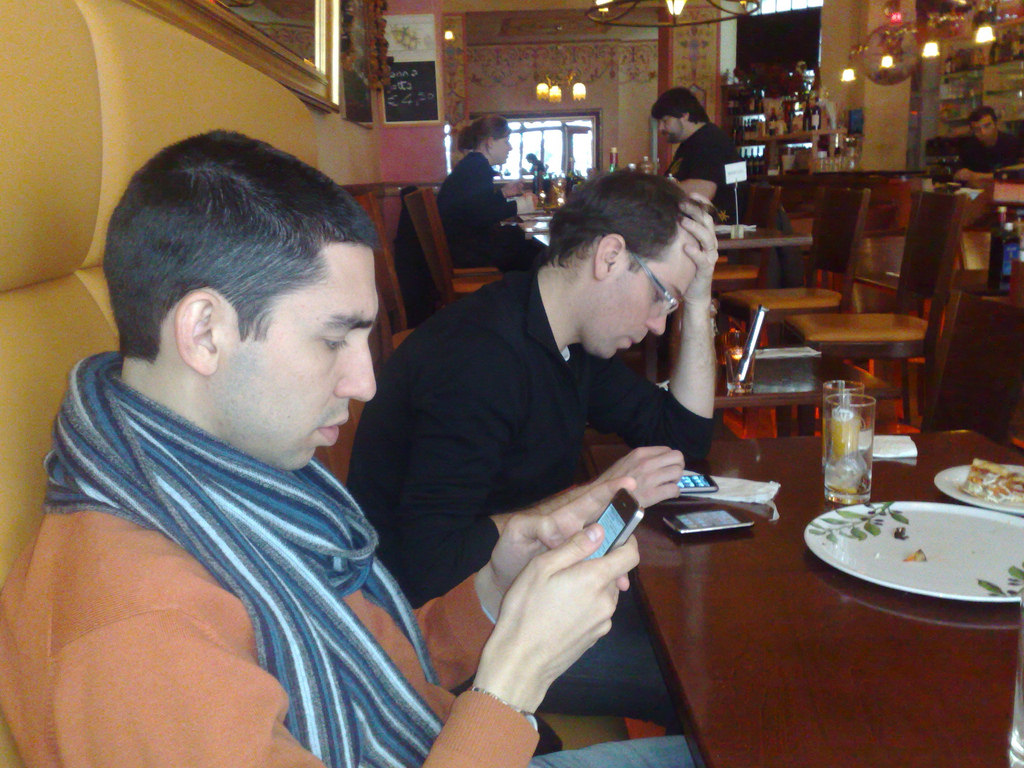
After fiddling around on the fringes of my more-digital-ready colleagues for several challenges, I suddenly remembered that my friend Pedro (that’s him on the right-hand back of the photo, sitting beside our friend João; note how two people are using three devices between them) was carrying an Android-powered phone with a “create a mobile wifi hotspot” capability. So I asked him, sheepishly, if he would mind sharing and he was only too happy to do so. And so all of a sudden the iPod Touch in my pocket, previously starved of wifi oxygen, was back online and I was in the thick of it, ultimately helping guide us to Auguststrasse (“street in Mitte named after a month”).
Over the course of the rest of the afternoon I asked Pedro, who switched off the wifi hotspot to save battery and data once I was done, to turn things back on a few more times, to allow for more research or, at one point, to let me top up my prepaid SIM using a web front-end.
Pedro is one of the nicest people you’ll ever meet, and so was happy to help a guy out of a jam.
But it also felt a little uncomfortably like he was my heroin dealer: he had the stuff that I needed, and he could switch it off at any point, leaving me jonesing for a bandwidth fix. I found the dynamic interesting, and projecting forward it’s fascinating to imagine how this hotspot-conjuring ability begins to acquire a sort of social cachet: being the guy with the hotspot becomes being like the guy who brings the basketball to the outdoor court, or the guy whose parents have cable TV.
I also found the experience interesting because it seemed like magic.
I know that it’s not magic, and indeed it’s not much more complicated that any of the gizmos that I use everyday. But someone Pedro’s ability to conjure up an Internet from his pocket – out of thin air – was amazing to me, and imbued him with great power and prestige.
We ended up losing the scavenger hunt to another team – how exactly we lost I was never sure, as it seemed to me that we did quite well – but it was fun afternoon nonetheless, got me out into the Berlin sunshine with old friends, and turned Pedro into a little but more of a magician than he was before.
I was buying myself a Fruit & Nut chocolate bar this afternoon — the king of “chocolate bars with things in them” in my eyes – over at the tobacco shop in the Confederation Court Mall. Standing at the cash, with my mind on 34 different things, I saw a label on the candy case that I took to read “Joe Sherman’s Friends” and thought to myself “wow, that’s a great name for a candy – I wonder what it is.”
As it turned out, I was looking at a somewhat distressed label for Fisherman’s Friends, and so I’ll never know the answer to that question.
In any case, it turns out that the late great Joe Sherman is, for some reason, flickering around the edges of my mind these days.
For someone like me, living in a city where “stationery store” has been been whittled down to mean “shopping at the big box store to buy a gross of envelopes,” it’s increasingly hard to remember what a good stationery store is like. In Berlin, though, there seems to be an excellent stationery store or two in every neighbourhood, and over the 10 days I was there this month I visited more than my fair share of them.
After the inhumanity of “there’s a 1-800 number on your receipt that you can call for a chance to rate your experience today and win $1000!” at checkout, I can’t tell you how nice it is to show in places that care enough about the power of paper, pens and pencils to carefully wrap them in a paper bag and seal the back with cello tape. And to allow me to buy just one or two of something – a sheet of paper, four envelopes – rather than a case.
Should you find yourself in Berlin, here’s a list of the places I found and enjoyed:
- R.S.V.P. on Mulackstraße 14 in Mitte (Weinmeisterstraße U) may be the nicest stationer there is: back into space not much bigger than your bedroom is a well-curated collection of paper, notebooks, rubber stamps, pens, and other paper goods presented on floor-to-ceiling shelves. It’s almost impossible to leave the shop without having purchased something, if only to express support that such places must thrive.
- Grüne Papeterie on Oranienstraße 196 (Kottbusser Tor U) is a nice little shop in Kreuzberg (note that it’s not where Google Maps shows it to be, but rather on closer to the corner of Marrinestraße and Oranienstraße) selling a good select of paper, notebooks, pens, pencils and other items. It’s cramped but well-stocked.
- Papier Concept on Kastanienallee 11 (Eberswalder Straße U) is more of a workaday stationer with less emphasis on the precious and more on the basics. But they have a nice selection of interestingly-constructed cards and envelopes, a very broad selection of notebooks large and small, and a nice selection of pens.
- Modulor on Gneisenaustraße 43-45 (Gneisenaustraße U) is actually an store focused on selling supplies to architectural model makers – all of those generic tiny people, tiny cars and all that tiny grass you see in architects’ tiny models of buildings – that has, in addition, a rather amazing selection of paper goods. I especially liked their huge selection of handmade paper made in India from recycled cotton rags and their broad selection of notebooks. But you’ll also find everything from felt letters to ink brayers. Well worth a visit to anyone remotely creative.
That’s just a small selection of what you’ll find. Needless to say that, as noted here, I came home to Charlottetown with a suitcase packed with paper products.
On the evening of the first day of the Cognitive Cities Conference in Berlin last weekend I ended up eating supper with a bunch of reboot veterans at 3 Schwestern, a restaurant in Kreuzberg located in Bethanien, an imposing building that once housed a hospital. The food was great (and inexpensive), as was the company.
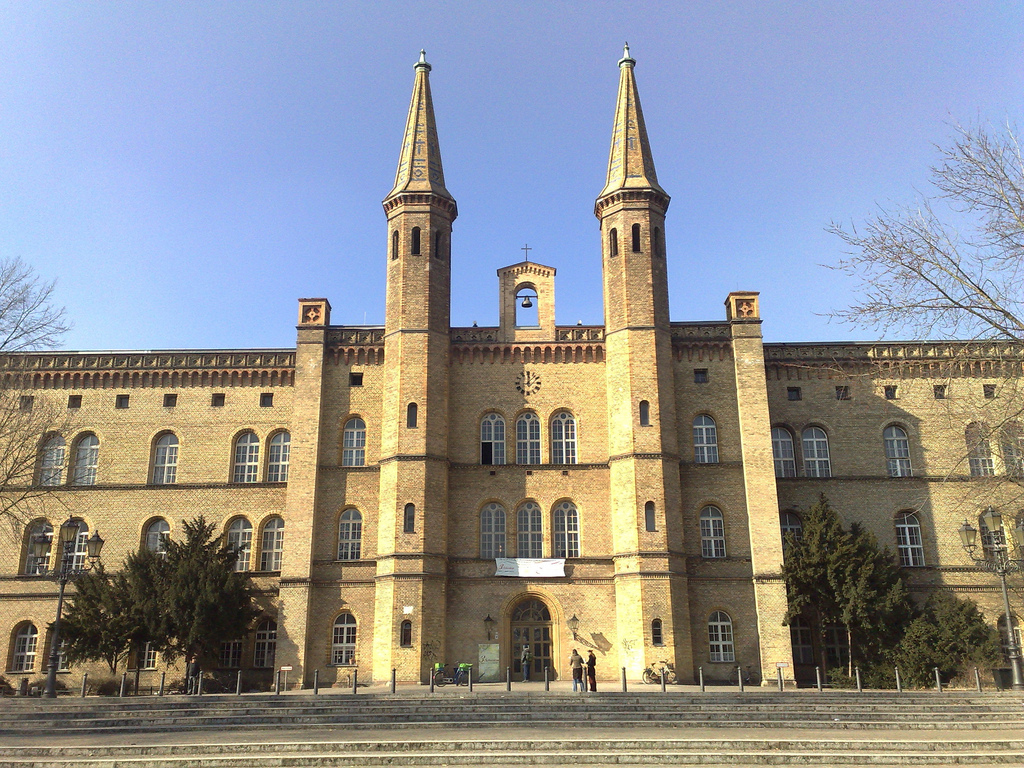
On returning from the washroom, my friend Luisa mentioned that she’d seen a poster in the hallway that suggested that elsewhere in the building was some letterpress equipment. I tracked down the poster, which mentioned something called Druckwerkstatt, and vowed to investigate later in the week.
On Wednesday morning I made my way back to the building, and asked at the information desk where I might find “the printing presses,” and was directed up the stairs on the left. What I found upstairs was amazing: room after room of people engaged in all manner of “the graphic arts.” In one room there were digital workstations and scanners, in the next there were people making etchings, and in yet another a photographic workshop. I rambled around unhindered until I encountered a helpful English chap who directed me downstairs into the basement to find the letterpress gear.
I found my way to a rickety old elevator, figured out how to make it go to the basement (it was painfully inobvious) and once in the basement rambled around some more until I came across a letterpress, a collection of type and related supplies:
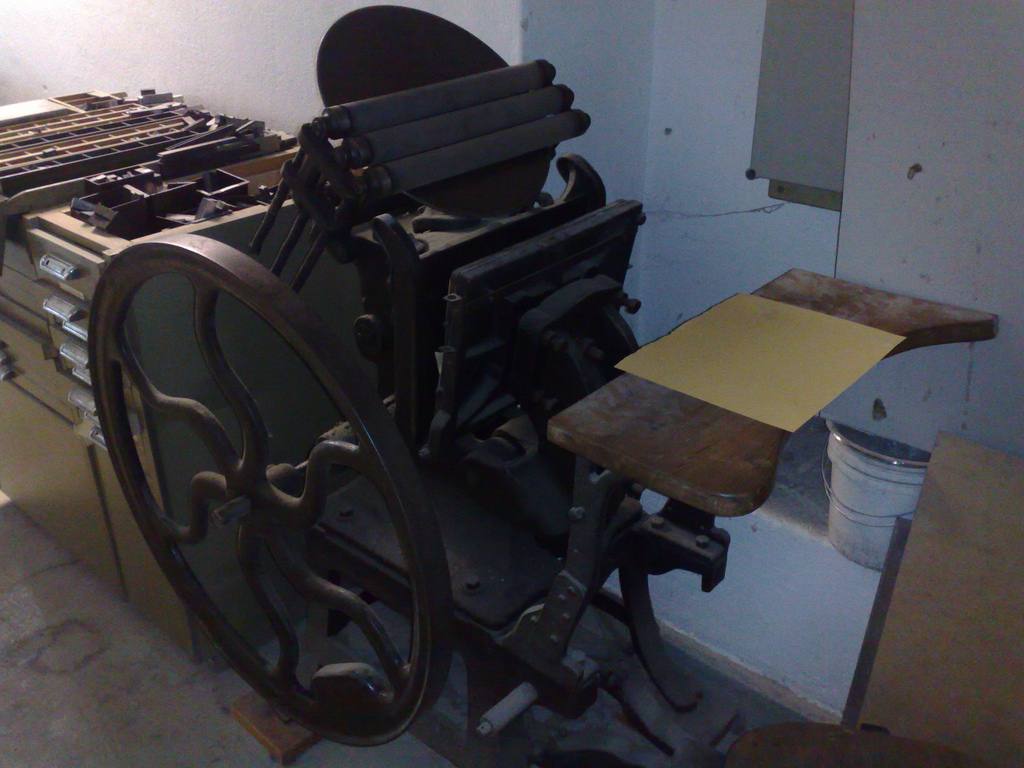
I had to dash to a lunch across town before I could learn any more, so it was only today that I learned that what I’d stumbled across was part of Kulturwerk des bbk berlin GmbH, a state-funded organization that offers “infrastructures for visual arts,” including Druckwerkstatt:
The Print studio in the Berlin district of “Kreuzberg” offers all the facilities for mechanical, chemical and digital printing techniques.
Ranging from the traditional printing methods, such as book printing, etching and lithography to screen-printing and offset print, the services on offer are regularly adapted to incorporate the latest technical developments. Additionally, the studio runs workshops for papermaking and bookbinding.
A whole range of printing methods may be realised: from traditional printing editions to crossover techniques and experimental projects.
What’s amazing is that all of this infrastructure appears to be available for use by anyone for very little in fees: everything from bookbinding (8 EUR/day) and digital scanning (10 EUR/day) to papermaking (8 EUR/day) and letterpress (8 EUR/day) is available.
This is the kind of thing that makes me want to spend the summer in Berlin making books and that reminds me how little public infrastructure for creation we have here on Prince Edward Island.
Longtime readers will recall that I am a longtime fan of former CBC Television Compass reporter Ian Petrie. Since Ian left the broadcast resource reporting on Prince Edward Island has never been the same. Add the departure of CBC Radio’s Mac Campbell from the airwaves several years before and we’re left with much less insight into the economic hearts of our province.
But I didn’t know the half of it: Ian Petrie has a blog now, called Food Matters, and if you thought Ian Petrie was good before, he’s even better once removed from the limitations of being a CBC reporter.
Starting reading the blog from the beginning, Let’s Say Grace First. And then keep going. You’ll learn more than you thought you had to learn about the practicalities and politics of the food system, wrapped in Ian’s witty, well-written prose.
The Internet can be a good thing.
I love it when internal names for merchandise leak out into public signage, as happened in this sign at Michaels in Charlottetown. I’m not entirely sure what “impulse” items means – are they things we’re to buy on impulse? In this case it was a variety of projects ranging from monogrammed coasters to little notebooks. Stocking stuffers if it were Christmas time. Michaels, by the way, despite being a multinational crafts supply giant, is also one of the most interesting stores you’ll ever visit: if you ignore the pre-created “scrapbooking” materials you’ll find a cavalcade of things you can use to make, well, whatever. It’s the perfect place for a letterpress printer looking for new things to print on.

 I am
I am